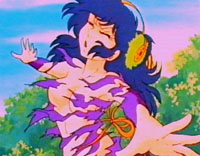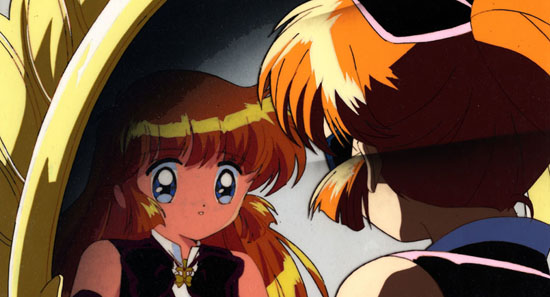 One aspect of Japanese animation that the gaijin fan learns early on is that much of it exhibits Shinto influences, deliberately or subtly. For many early fans, it was the character of Benten in Urusei Yatsura. Many of space invader Lum’s teenage friends from outer space were thinly-disguised Japanese mythological characters including Shinto divinities. Benten, a space-motorcycle-riding, swearing tomboyish gal-pal in a chain-mail bikini and with a bazooka, was based on Shichifukujin Benzaiten, one of Shintoism’s Seven Lucky Gods. One of Benzaiten’s divine aspects is Bishamonten, defender of the nation; hence Benten’s warrior appearance.
One aspect of Japanese animation that the gaijin fan learns early on is that much of it exhibits Shinto influences, deliberately or subtly. For many early fans, it was the character of Benten in Urusei Yatsura. Many of space invader Lum’s teenage friends from outer space were thinly-disguised Japanese mythological characters including Shinto divinities. Benten, a space-motorcycle-riding, swearing tomboyish gal-pal in a chain-mail bikini and with a bazooka, was based on Shichifukujin Benzaiten, one of Shintoism’s Seven Lucky Gods. One of Benzaiten’s divine aspects is Bishamonten, defender of the nation; hence Benten’s warrior appearance.
Almost any anime that involves a Shinto temple or shrine will feature that shrine’s temple maiden as a prominent character. She is usually a close friend of the protagonist, and is usually the young teenage daughter of the shrine’s hereditary chief priest. Examples are Urusei Yatsura’s Sakura (pictured, above left), who is also Tomobiki High’s school nurse; Kamichu’s Matsuri Saegusa, a junior high classmate of protagonist Yurie; and InuYasha’s Kagome Higurasha, the 15-year-old daughter of the neighborhood shrine chief priest who is the modern reincarnation of the shrine’s 15th-century’s warrior priestess Kikyo.
Saint Tail (43 TV episodes, October 12, 1995-September 12, 1996; directed by Osamu Nabeshima at Tokyo Movie Shinsa) presents a bizarre, superficially Roman Catholic variant of this. Seira Mimori is a 13-year-old nun-in-training at St. Paulia’s Private (Catholic) School who is the best friend of student Meimi Hanaoka. Seira learns of people’s problems, usually the result of their being victims of crimes, while hearing their Confessions; and she reports them to Seira, who prays to God and is transformed into Saint Tail, in a costume based on a Las Vegas stage magician’s assistant, to correct the injustice. Take my word for it; in Roman Catholicism, nuns do not hear Confessions, especially not 13-year-old nuns-in-training!

Many of the ceremonies of Shintoism at the larger shrines are ritual dances, kagura, performed by groups of young virgin girls accompanied by traditional musical instruments. Before the end of World War II, when the powers of Shintoism were believed in more seriously, there were ritual dances to protect Japan from military defeat. Three anime productions, two by Ohji Hiroi or Ouji Hiroi, have been extrapolated from this.
Sakura Wars. Sakura Taisen. This actually began as a Sega video game in 1996. It was so popular that it led to a six-episode OAV series (1997-1999, directed by Takaaki Ishiyama, produced by Studio Madhouse), a 25-episode TV series (April 8 to September 23, 2000, directed by Takashi Asami, produced by Madhouse), Sakura Wars: The Movie (85 minutes, December 22, 2001, directed by Mitsuru Hongo, produced by Production I.G), and more video games, OAVs, novels, and manga over the next half-dozen years.

Sakura Wars is set in an alternate history centered around Tokyo in the early 1920s. Japan is just recovering from the Demon Wars, an equivalent of World War I in which Earth, particularly Japan, was invaded by fearsome monsters. They were defeated, but everyone expects them to attack again soon. The Kanzaki Heavy Industries company in Tokyo has developed steam-powered battle suits to combat them, but only soldiers with strong psychic energy can move them. To macho Japan’s embarrassment, the only psychic recruits that can be found are young international virgin girls. The girls let the traditional military’s dependence upon them go to their heads, painting their battle armor in bright pastel colors. The government organizes them into the Flower Brigade (Hanagumi), a secret battle group disguised as the Imperial Revue, a theatrical troupe similar to the real Takarazuka Revue. The Flower Brigade consists of their commander, Lieutenant Ichiro Ohgami, the only male with psychic energy (the stereotypical anime shy young man in charge of a group of uncontrollable adolescent girls), and the psychic virgins: Sumire Kanzaki, arrogant daughter of the president of the company that makes the battle suits; gun expert Maria Tachibana (Russian), mechanical genius Li Kohran (Chinese), telekinetic Iris de Chateaubriand (French; nine years old with a teddy bear), martial-arts expert Kanna Kirisima (Okinawa), fingertip laser-beam shooting Orihime Soletta (Italian), and battlefield tactician Leni Milchstraße (German). Conflict is introduced when another Japanese girl, Sakura Shinguji, is found who has the psychic energy and is drafted into the Brigade. She just wants to help, but Kanzaki considers her to be a rival. When the Demon Lords of Death invade Tokyo again, resulting in the fictional damage caused by the real 1923 earthquake that destroyed Tokyo, the squabbling girls have to learn to get along and fight effectively.
Besides the animation, the action figures and dolls of the girls in their individualistic bright-pastel 18th-century Western military officers’ uniforms were very popular.
Virgin Fleet. Seishoujo Kantai Virgin Fleet (“Feminine Energy Naval Warfare Virgin Fleet”). Three 30-minute OAVs, April 25, 1998, July 25, 1998, October 25, 1998.

This minor production, directed by Masahiro Hosoda at AIC, got almost unanimous negative reviews, but the premise is intriguing. The setting is an alternate world in which atomic power has not been developed, but Japanese research into paranormal mental powers has awakened psionic energy in some humans — but only young women, and only as long as they are virgins. Fifteen years earlier, in a conflict similar to World War II but supposedly a followup to the Russo-Japanese War of 1905, a ship of young women with this talent sunk a “federation” fleet about to invade Japan. This resulted in a cease-fire that has lasted to the present. A naval girl’s academy, the Nakano Naval Academy, has been opened to train new girls with psychic “Virgin Energy” to crew a “Virgin Fleet” to protect Japan.
This is the background for a mostly silly teen farce. After fifteen years, Japan has been at peace for so long that the academy has turned into a finishing school where giggly teen girls play at being sailors and navy aviators. New student Shiokaze Umino has enrolled only to demonstrate she is still a virgin, to make a respectable bride for handsome naval cadet Mau Sakisaka. The academy’s cadet leader Satsuki Yukimizawa, who is overly serious about the fleet’s military mission, is determined to force Shiokaze out. The schoolgirl catfights (with Mau as a comically inept mediator) play into the hands of naval Chief Tatsugawa, a reactionary who has been trying to persuade the government to abandon the Virgin Fleet and rebuild the Imperial Navy. When enemy/Russian spies attempt to sabotage the Virgin Fleet in preparation to reactivating the war, Satsuki is eager to put the Fleet into action at last, but she lacks enough Virgin Energy to be effective. Shiokaze has the energy, but she freezes in panic at the prospect of real danger.
What is most interesting about Virgin Fleet to me is the background portrayal of a Japan that has modernized without the dominating cultural influence of a Western occupation. There is technical modernization in appliances and the news media, but architecture and clothing styles are closer to those of 1940s Japan. The score by Masumi Ito is modern movie-music when punching up the action scenes, but in the style of traditional Japanese music in the street scenes. Even the opening and closing theme songs by Chisa Tanabe are pseudo-1940s or 1950s Japanese pop music, before it became as heavily Westernized as in our world today.
Strike Witches. This began as a series of columns by Humikane Shimada in Comp Ace, a Japanese computer game magazine in 2005, and was made into novels, a 24-minute OAV, two animated TV series of 12 episodes each (2008 and 2010), and Strike Witches: The Movie (97 minutes, March 17, 2012). (TV and movie animation directed by Kazuhiro Takamura; animation of the first TV series produced by Studio Gonzo, the rest by AIC.)

As with Sakura Wars, Strike Witches is set in an alternate Earth with a major war replaced with a battle against demons, or otherworldly invaders. In this case, it is World War II. The countries are mostly transparent fictions of the nations on both sides in World War II, and the enemy is the Neuroi, whose weapons are really ominous CGI fighter aircraft. The Strike Witches are young girls with psychic energy, from the world’s armies who are all assigned to the 501st Joint Fighter Wing in Britannia. Each Witch has a Striker Unit, mechanical leggings with propellers that enable her to fly and use her psychic energy to fight the Neuroi’s aerial weapons. The anime concentrates on young Yoshika Miyafuji who joins the 501st Joint Fighter Wing. As an all-girl unit fighting unseen hive creatures, there is an emphasis on the personality conflicts among the human characters: Major Mio Sakamoto and Yoshika Miyafuji of Fuso (Japan); Commander Minna-Dietlinde Wilcke, Erika Hartmann, and Gertrud Barkhorn of Karlsland (Germany); Charlotte “Shirley” E. Yeager of Liberion (U.S.A.); Lynette Bishop of Britannia (Britain); Perrine H. Clostermann of Gallia (France); Francesca Lucchini of Romagna (Italy); Eila Ilmatar Juutilainen of Suomus (Finland); and Sanya V. Litvyak of Orussia (U.S.S.R.); the 11 international girls of the 501st Joint Fighter Wing.
The first TV series is roughly equivalent to the 1940 Battle of Britain; the second TV series is roughly equivalent to the Allied conquest of Italy; and the theatrical feature is roughly equivalent to the Battle of the Bulge. This emphasizes a different aspect of the nature of the psychic young women; late in the first TV series, Major Sakamoto begins to lose her psychic powers when she turns twenty, and becomes too old to be a teenage fighting virgin any more.
Yeah, but this does not explain why they are such very young women, apparently of barely adolescent age (Yoshika looks nine or ten, though she’s officially 16) with Big Breasts and Bigger Guns; or why using their psychic powers transforms them into dog- or rabbit- or cat-girls; or why there are so many crotch-&-panty shots and nude scenes. I have never seen an anime series with so much fan service; in some episodes the girls’ boobs are almost bigger than their guns! And episode 7 – NSFW! The first TV series was broadcast from July 4 to September 19, 2008 at 1:20 to 1:50 a.m. Obvious references to Shintoism, Strike Witches does NOT have!
Will Japanese animation be able to develop any further the theme of young women using psychic powers for military purposes? It seems unlikely, but it is such an unlikely theme in the first place…


 Fred Patten (1940-2018) was an internationally respected comics and animation historian. He has written about anime or comic books for publications ranging from Animation Magazine and Alter Ego to Starlog. He was a contributor to The Animated Movie Guide (2005), and is author of Watching Anime, Reading Manga (2004, Stone Bridge Press), a collection of his best essays, and Funny Animals and More (2014, Theme Park Press), based upon his early columns here on Cartoon Research. He passed away on November 12th, 2018.
Fred Patten (1940-2018) was an internationally respected comics and animation historian. He has written about anime or comic books for publications ranging from Animation Magazine and Alter Ego to Starlog. He was a contributor to The Animated Movie Guide (2005), and is author of Watching Anime, Reading Manga (2004, Stone Bridge Press), a collection of his best essays, and Funny Animals and More (2014, Theme Park Press), based upon his early columns here on Cartoon Research. He passed away on November 12th, 2018.





































Your write up on Sakura Taisen has some major timeline errors. While it’s true that Sakura joins the Hanagumi after Sumire, Iris, Kohran and Kanna, she has been a member for months before Oogami is brought in to be their commander. Also, Leni and Orihime do not become Hanagumi members for about two years following that(They debut in Sakura Taisen 2 on the Saturn, and it’s corrosponding OVA)
“Take my word for it; in Roman Catholicism, nuns do not hear Confessions, especially not 13-year-old nuns-in-training!”
Way to give my hopes up, Fred!
About Sakura Wars…
“and more video games, OAVs, novels, and manga over the next half-dozen years.”
And yet we never got the games! I just had to say it.
“Will Japanese animation be able to develop any further the theme of young women using psychic powers for military purposes? It seems unlikely, but it is such an unlikely theme in the first place…”
Please don’t give them ideas! 😛
On Sakura Wars, we DID get Sakura Wars 5 in the US. And some crazy people like me who imported the other 4, and played them with the gamefaqs translation guides =P
But yes, Sakura Wars 5 got a US release for the Wii and PS2 some years ago. The Wii version was dubbed into english, the PS2 version came with 2 discs, one subtitled and one dubbed.
I didn’t think we were that lucky (but then I probably lost interest after the first three games), I recall one person I know who was so big into it that he had to import those games and even the voice actors live-stage performances on disc, today he’s in Japan with a wife and daughter (the dream most of us would never see to fruition if not for what he had to go through to achieve it).